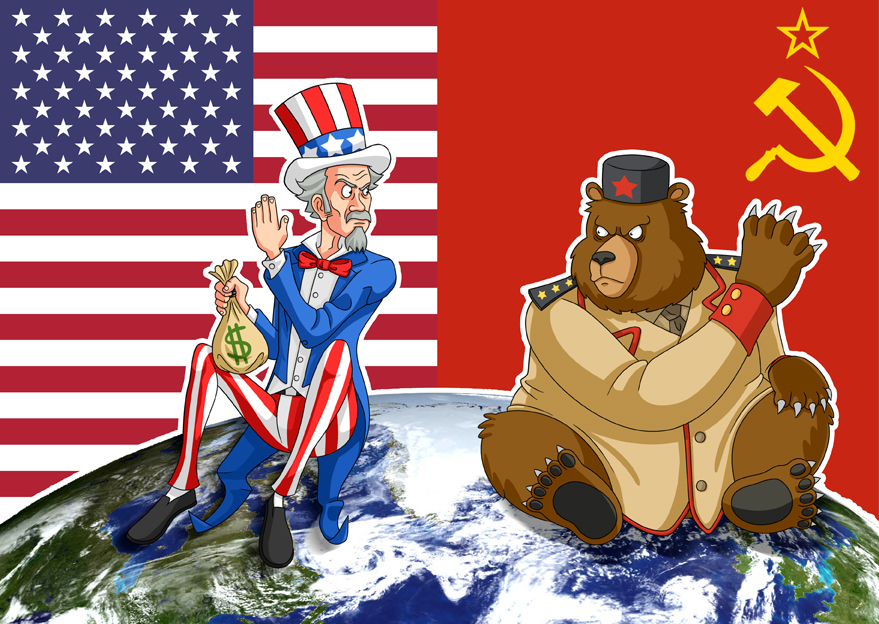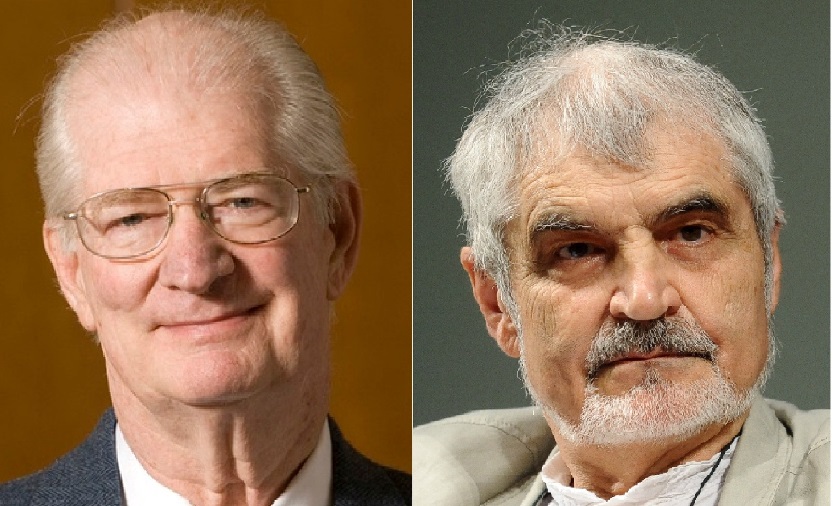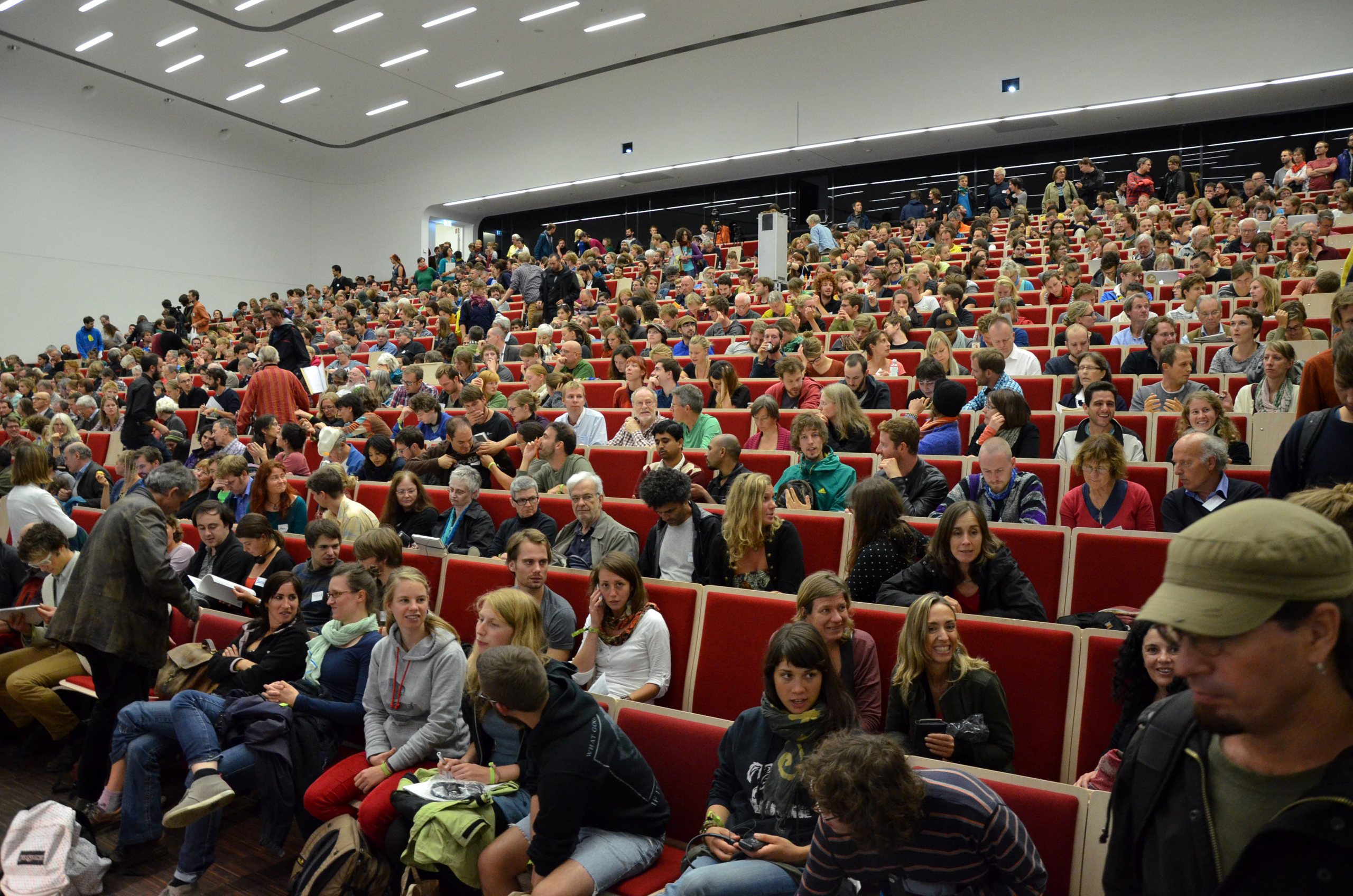Co-Written By Brian Czech and Riccardo Mastini
Limits to Growth and the Environmental Movement
No later than the 1960s, scholars wrote in rigorous terms of the limits to economic growth. Europeans such as E.F. Schumacher, Americans including Herman Daly, and European-born Americans (most notably Nicholas Georgescu-Roegen and Kenneth Boulding) set the stage for later studies in ecological economics and sustainability science. Their scholarship, supplemented by the population focus of Paul Ehrlich and the modeling approach of Donella Meadows and coauthors (for the Club of Rome), resonated with ecologists and opened the eyes of millions of concerned citizens worldwide.
The “limits to growth movement” was allied in effect with the environmental movement of the 1960s and early 1970s. As indicated by the events of the first Earth Day in 1970, the environmental movement had a global aspect and was a major political phenomenon in many countries. It too had its progenitors. In the USA Rachel Carson, Barry Commoner, and David Brower were in the vanguard, and limits to growth were in their academic DNA. They were essentially “economists of nature” who were steeped in the concept of carrying capacity.
The cumulative movement—limits to growth and environmental protection—was characterized by a rapidly mounting concern over destructive economic activity. The critique of growth was therefore accompanied by skepticism about the behavior of corporations. In Europe, especially, the sustainability of capitalism itself was called into question, with or without Marxist leanings.
Although the critique of growth was focused on and in capitalist countries, astute observers noted an obsession with economic growth in socialist and communist countries as well. At the time, the most profound example was the Soviet Union. The Cold War, after all, was waged in terms of GDP, as described in meticulous detail by Robert Collins in More: The Politics of Economic Growth in Postwar America.
While the cumulative movement had some tangible successes, these were primarily of a regulatory nature for specific environmental protections, including clean air policies and the establishment of national parks in the UK and France. Meanwhile in the USA, the Clean Air Act and the Clean Water Act were passed, and the Environmental Protection Agency was established to give the legislation teeth. The National Environmental Policy Act also helped to prevent the “sneaking” of environmentally devastating projects into the federal budget without copious public review and discussion.

The Cold War score was kept in GDP and was, therefore, highly unsustainable. (Image CC BY-SA 4.0, Credit: Carlos3653)
Little, on the other hand, was done to actually check the rates of economic growth in Europe or the USA. In fact, virtually nothing was done explicitly to that effect, and hardly anyone aside from Herman Daly even called for it in policy terms.
Perhaps the closest thing to macroeconomic reform was the Endangered Species Act of 1973. In the preamble, the 93rd American Congress found and declared that “species have been rendered extinct as a consequence of economic growth and development…” and went on to provide strict protections for threatened and endangered species. In essence, the Endangered Species Act was an implicit (and unintended, for most legislators) prescription for a steady state economy, albeit a steady state with a long list of species dangling from one last twig on the tree of life (see Czech and Krausman 2001).
The alternatives to growth were always obvious, starting with the opposite of growth; that is, recession, shrinkage, or “degrowth.” In between the two opposites was stability, equilibrium, or what Daly called the “steady state economy.”
Daly vs. Georgescu-Roegen: Less a Debate than a Different Frame of Time
When Daly started advancing the steady state economy as the sustainable alternative to growth, Georgescu-Roegen protested, as he had described in magnificent detail the unrelenting forces of entropy, which eventually brings down any economy on Earth as the sun runs out of hydrogen. But Daly acknowledged as much. Indeed Daly’s steady-state economics was born out of insights derived largely from Georgescu-Roegen, who was Daly’s Ph.D. advisor at Vanderbilt.
The contrast between Daly’s steady-state emphasis and Georgescu-Roegen’s entropy focus was hardly a political debate with policy implications. Instead it was theoretical and philosophical, applying primarily to the longest of long terms, not policy-relevant planning terms. Daly’s favorite metaphor of a long-term economy was a candle. The candle must first be lit, then will burn, and eventually must die out. The candle’s “production” can approximate a steady state for all but the lighting and the dying.
Unfortunately, however, the global economy was starting to look like a Roman candle with a suddenly vulnerable wick. Non-renewable resources—or “natural capital” stocks—were being liquidated, and the economy would have to recede to a level sustainable with renewable resources. This was a matter of common sense, yet the laws of thermodynamics were required to refute the notions of neoclassical economists who believed in perpetual substitutability of resources in an ever-growing economy.
There was a sort of middle ground: Within limits, additional mastery over the use of renewables could take up some of the slack as non-renewables were liquidated. Also during this adjustment phase, recycling of non-renewables would still be economic. An emphasis on efficiency has found renewed vigor with visions of a “circular economy.”
A Sustainability Slogan for the 21st Century: Clear, Accurate, and Policy-Relevant
Our focus for the current purposes, however, should be less on the technics of growth, degrowth, or the steady state economy, and more on the political common ground of degrowth and steady-state movements. The predominantly European “degrowthers” and the predominantly American (and Australian) “steady staters” would all have more cachet, influence, and success if they were united in their efforts to topple economic growth from the pedestal of politics and policy.
Our unified slogan ought not be simply “steady state economy” or “degrowth,” but rather “Degrowth Toward a Steady State Economy.” The slogan is perfectly clear, charts a path, and readily rolls off the tongue. It passes the test for effective slogans.
The vast majority of tips on communications, rhetoric, and marketing come from the context of business. While we can’t reduce social movements and statesmanship to salesmanship, the basics of effective slogans would seem to apply in all scenarios. Consider for example the “5 Tips for Writing an Effective Slogan” described by Dan Smith of Business Insider.
Smith’s tips 1 and 2 overlap substantially. Tip 1 is, “Highlight a key benefit. The point of a slogan is to differentiate your product or brand from that of your competitors, while also underscoring the company’s general mission.” Tip 2 is, “Explain the company’s commitment… differentiate the company from other competitors.”
How could we possibly explain our commitment more clearly with a handful of words? “Degrowth Toward a Steady State Economy.” This is our vision of sustainability, including environmental protection, economic sustainability, and peace among nations. As for differentiation, in calling for a clear alternative to growth, how could we be more differentiated from Wall Street, the World Bank, and most governments of the world, each of whom are competitors for the macroeconomic vision of the 21st century?
Tip 3. “Keep it short. Slogans should never be longer than a sentence and ideally should hit the sweet spot between six to eight words.”
“Degrowth Toward a Steady State Economy” weighs in at precisely six words comprising eleven syllables.
Tip 4. “Give them a rhythm, rhyme, and ring. A slogan longer than a single word should fulfill at least two of these three criteria.”
Well, there’s only so much you can do with a topic as heavy and demanding as limits to growth. We’re not selling paper towels here (the example provided at Smith’s article). Given the scope of the topic, it’s a relief that “Degrowth Toward a Steady State Economy” contains no problematic phonetics and causes no tongue-twisting. Also, in the context of discussions, articles, or media coverage, after the slogan has been introduced it can be referred to with the shorthand, “degrowth toward a steady state,” which rolls off the tongue more readily yet. For those so inclined, even rhyming is not out of the question. It isn’t difficult to imagine the late Kenneth Boulding quipping, “Degrowth toward a steady state—do it ‘fore it’s way too late.”
Tip 5. “Stay honest. When writing a slogan, it’s extremely easy to get carried away; however, it’s imperative that the slogan accurately reflects the business. In other words, hyperbole is extremely discouraged.”
How could we be more honest about what “business” we’re in? We’re offering the sustainable alternative to growth, not some dishonest oxymoron such as “green growth” or “sustainable growth.” Nor are we exaggerating with, for example, “degrowth toward Heaven on Earth,” or “degrowth for infinite ecstasy.” We are advocating, quite clearly, for degrowth toward a steady state economy. Why not call it precisely that?
Disharmony Between North American and European Sustainability Advocates?

Herman Daly (left) and Serge Latouche (right), champions of the steady-state and degrowth movements, respectively. (Left Image: credit by Herman Daly; Right image: Image CC BY-SA 3.0, Credit: Niccolò Caranti)
One wonders why “Degrowth Toward a Steady State Economy” hasn’t proliferated already among degrowthers and steady staters. Certainly the connection got off to a promising start in 2002. That’s when Herman Daly and Serge Latouche were honored side by side in Rimini, Italy, each with a Medal of the Italian Government for their groundbreaking work in steady-state and degrowth economics, respectively.
At CASSE, we use “degrowth toward a steady state economy” a lot, especially in speeches and social media, helping to empower the degrowth movement along with steady-state economics. The slogan works perfectly fine in academic articles as well (see for example O’Neill 2012, Sapinski 2015). In 2018 the nascent DegrowUS adopted the mission statement, “Our mission is a democratic and just transition to a smaller, steady state economy in harmony with nature, family, and community.” Yet the phrase “steady state economy” seems glaring in its absence from the European scene today, even in English-speaking venues. We can think of several potential reasons, and heretofore we hypothesize briefly about two.
Might it be, ironically, that Americans from broader sustainability circles are largely responsible? Many elder Americans, especially, still have Cold War sensitivities, whereby the phrase “steady state economy” evokes thoughts of the Soviet Gosplan, the central economic planning apparatus of the Soviet era. Such sensitivities may be largely subconscious, as several generations of Americans were essentially “programmed” into fear or loathing of the Soviet Union and, by association, central planning of economic activity. Self-aware scholars and sustainability leaders, while themselves long past the Cold War, may strongly suspect—perhaps correctly—that much of the American philanthropy community (which tends to be elderly by its nature) would not cotton the phrase.
Avoidance of the phrase “steady state economy” for fear of being politically marginalized (and losing out on grant money in academia and the non-profit sector) is understandable, but it hasn’t been helpful for advancing the steady state economy, much less degrowth, in politics and policy. If only American leaders in environmental protection, economic sustainability, and international diplomacy had spent some time sharpening their steady-state rhetoric over the past five decades, “steady state economy” would be far closer to vernacular. Only when explicit discussion of the steady state economy is in the vernacular can we expect American policy reforms conducive to degrowth toward a steady state economy.
The second hypothesis pertains to a small but vocal group of Marxists from several continents who have stubbed a collective toe on the work of Herman Daly. Daly has acknowledged the relative efficiency of markets for allocating a very specific and limited set of goods; namely “rival and excludable goods” (basically the small stuff such as boots and tin cans), and definitely not public goods and services (the big stuff such as environmental protection and national defense). Daly has also proposed solutions that entail tightly regulated market mechanisms, such as cap-and-trade systems conducive to sustainable scale, just distribution, and efficient allocation. Furthermore, Daly and generations of students, including textbook co-author Josh Farley, have recognized in detail the types and sources of market failure, even among the widget sectors (see for example Daly and Farley 2010).
Despite Daly’s careful, nuanced, and discerning assessment of markets and market-like mechanisms, the handful of vocal reactionaries seem to view him as an apologist for laissez-faire capitalism! This incredibly ironic misinterpretation of Daly’s life and work has furthermore led additional folks to overlook, ignore, or even object to steady-state economics itself, the highlight of which is, of course, the steady state economy as macroeconomic goal. Steady-state economics might be the biggest baby to ever be tossed with any bathwaters.

2014 Degrowth Conference, Leipzig University. Hundreds of degrowthers have signed the CASSE position on economic growth at degrowth conferences since the beginning of the movement. (Image CC BY-SA 3.0 DE, Credit: Eva Mahnke)
To the extent that sustainability advocates are misled into thinking of Daly—and even all of steady-state economics—as a capitalist enemy instead of a perfectly natural ally, it cripples the collective non-growth movement.
Coming Full Circle
Whenever a question arises about the macroeconomics of sustainability, it behooves us to consider the three basic alternatives: growth, degrowth, and the steady state economy. Neither growth nor degrowth are sustainable in the long run. This is most obvious in the case of degrowth. Meanwhile, the full body of work by Herman Daly, CASSE, and our many friends and colleagues in ecological economics (not always well-represented in Ecological Economics) makes it obvious enough regarding growth as well. This leaves the steady state economy as the sustainable alternative.
But what if—as indeed is clearly the case—the present economy has already grown too large for sustainability, much less optimality? (Think especially of American, European, and global economies.) Well, that brings us full circle:
No later than the 1960s, scholars wrote in rigorous terms of the limits to economic growth. Europeans such as E.F. Schumacher, Americans including Herman Daly, and European-born Americans (most notably Nicholas Georgescu-Roegen and Kenneth Boulding) set the stage…
Literature Cited
Collins, R.M. 2000. More: The politics of economic growth in postwar America. Oxford University Press, Oxford, U.K. 299pp.
Czech, B., and P.R. Krausman. 2001. The Endangered Species Act: History, conservation biology, and public policy. Johns Hopkins University Press. 212pp.
Daly, H.E., and J. Farley. 2010. Ecological economics: principles and applications. Second edition. Island Press, Washington, DC. 544pp.
O’Neill, D.W. 2012. Measuring progress in the degrowth transition to a steady state economy. Ecological Economics 84:221-231.
Sapinski, J.P. 2015. Climate capitalism and the global corporate elite network. Environmental Sociology 1(4):268-279. (http://dx.doi.org/10.1080/23251042.2015.1111490)
About the Authors
Brian Czech, Ph.D., is the founder and executive director of the Center for the Advancement of the Steady State Economy. He is the author of three books, Supply Shock, Shoveling Fuel for a Runaway Train, and The Endangered Species Act, as well as more than 50 academic journal articles. He served as a conservation biologist in the headquarters of the U.S. Fish and Wildlife Service from 1999-2017 and as a visiting professor of natural resource economics in Virginia Tech’s National Capitol Region.
Riccardo Mastini is a Ph.D. candidate at the Autonomous University of Barcelona, where he specializes in ecological economics and political ecology. He is a member of the academic collective Research&Degrowth and one of the editors of Degrowth.info,. Previously with Friends of the Earth Europe, he is also CASSE’s Barcelona Chapter Director.






